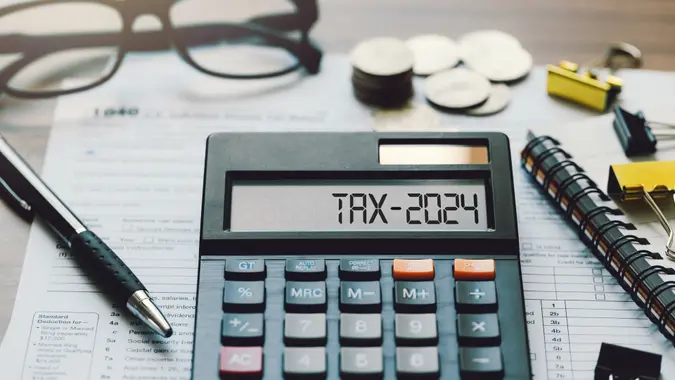The Biggest Mistake People Make With Their Tax Refund — And How to Avoid It

Commitment to Our Readers
GOBankingRates' editorial team is committed to bringing you unbiased reviews and information. We use data-driven methodologies to evaluate financial products and services - our reviews and ratings are not influenced by advertisers. You can read more about our editorial guidelines and our products and services review methodology.

20 Years
Helping You Live Richer

Reviewed
by Experts

Trusted by
Millions of Readers
Tax refunds can be used for any number of practical purposes, like paying down debt or building your savings. But refunds can also be blown on things you don’t really need. The good news is, many Americans make smart choices with their money, and you can, too.
According to a 2024 survey conducted by GOBankingRates, 25% of people plan to put their tax refund in savings this year. About 13% said they would use it to pay bills, while 15% planned to pay off debt.
Planning your taxes is another important step, and many Americans do a good job of that as well. About 73% aimed to file their taxes well before the April 15 deadline. More than 43% planned to file taxes themselves, using a tax software program such as TurboTax.
Don’t Make This Mistake
These are all positive trends. But even with roughly two-thirds of people planning to use their tax refund for practical purposes, that leaves about one-third who might make the biggest tax refund mistake — blowing it on frivolous or unnecessary things, such as an expensive vacation or new car you don’t really need.
There are much better ways to use your tax refund so that the money works for you instead of against you. For example, putting your refund into a high-yield savings account means the money will grow at a solid and predictable rate while also being protected by the Federal Deposit Insurance Corporation (FDIC).
One of the best savings options is Milli Bank. Milli is a mobile-only bank owned by FNBO whose savings account pays 4.75% APY as of Feb. 29, 2024, making it one of the highest in the industry. There are no monthly service fees or minimum-balance requirements with the Milli Savings account, and all deposits are insured by the FDIC.
Milli also offers a spending account and a feature called Jars that lets you personalize your savings.
Putting your tax refund into a savings account can help you build wealth for the future. In contrast, blowing your refund on something you don’t need or won’t use could put you in a deeper financial hole.
Look at the Big Picture and Make a Plan of Action
One way to avoid this tax-refund mistake is to make a list of your financial goals and how you expect to achieve them. This will help you look beyond immediate gratification and focus on steps that can bolster your financial situation.
Here are a few things to consider:
- Bills you need to pay now: Ideally, you won’t use your tax refund to pay bills that you should be paying with your regular income. But if you are behind on some of your bills and find it hard to catch up, it’s fine to use part of the tax refund to get current.
- Revolving debt: Credit card debt is one of the biggest roadblocks to financial security — and getting rid of it is one of the best financial moves you can make. Don’t be afraid to use your tax refund to pay off credit cards.
- Other debt: If you have other debt, such as a car loan or student loan, you might want to use part of your tax refund to get ahead on those. Doubling up your payments can help pay them off faster. Just make sure there’s no penalty for doing that.
- Short-term savings goals: If you don’t already have an emergency fund, then a tax refund is a great way to get started on one. You should aim to build a fund that can cover at least three to six months’ worth of expenses in the event of a sudden job loss or unexpected expense. If you already have an emergency fund, then list some other short-term goals, such as saving for a car or mortgage. Set up separate savings or CD accounts for these items and use your tax refund to fund them.
- Long-term savings goals: No matter your age, it’s never too early to set money aside for retirement. Investing your tax refund into an IRA or other type of retirement savings account can pay dividends down the road. If you have young children, you might also put a priority on saving for their college education. In this case, consider investing some of your tax refund into a 529 plan or similar college fund.
- Investment goals: It’s important to maintain a balanced portfolio that includes not only bank and retirement accounts but also stocks, bonds, mutual funds and other investments. Using your tax refund to balance your portfolio through stock, bond or mutual fund investments is another smart move.
More From GOBankingRates
 Written by
Written by 

























